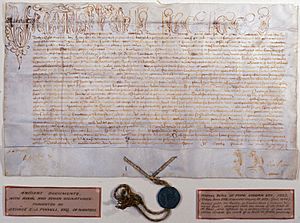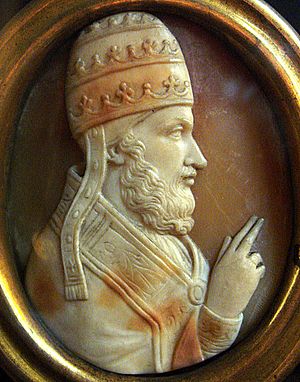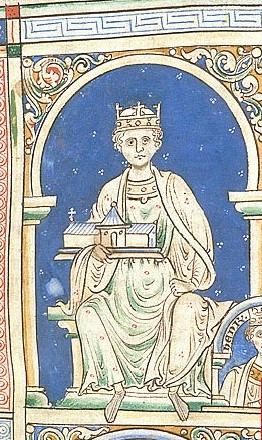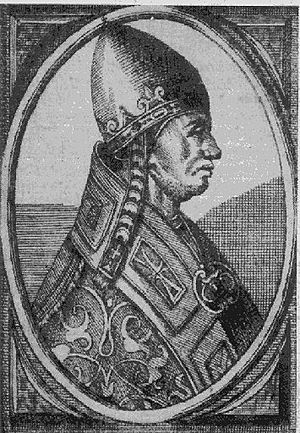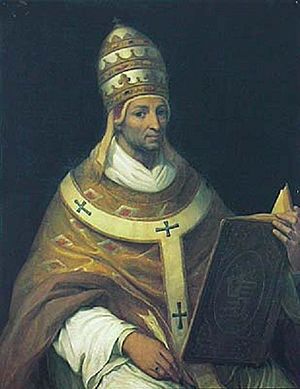Laudabiliter facts for kids
Laudabiliter was a special letter, called a bull, sent in 1155 by Pope Adrian IV. He was the only English pope ever. This letter supposedly gave King Henry II of England permission to go to Ireland. The goal was to help reform the Irish Church and bring it closer to the ways of the Latin Church. For a long time, people have argued if this letter was real, because no original copy exists today. However, many old writings from the 1200s mention it, which makes many historians believe it was real.
The bull was said to give King Henry II the right to invade and rule Ireland. It also aimed to make the Irish Church follow the rules of the Gregorian Reforms. Later, leaders of the Norman invasion of Ireland (1169–1171), like Richard de Clare (also known as "Strongbow"), claimed Laudabiliter gave them permission for their invasion. These Cambro-Norman knights were asked to help Diarmuid MacMorrough, a king who had lost his land in Leinster. He wanted their help against the High King of Ireland, Ruaidrí Ua Conchobair.
English kings, from Henry II (1171) to Henry VIII (1541), used the title Lord of Ireland. They said this title came from Pope Adrian's successor, Pope Alexander III.
After nearly 400 years, England's Church broke away from the Pope. This meant they needed a new reason for English kings to rule Ireland. So, in 1542, the Crown of Ireland Act was passed. This law created a new Kingdom of Ireland with Henry VIII as its king. But in 1555, Pope Paul IV issued his own bull, "Ilius, per quem Reges regnant". This bull gave the crown of Ireland to Philip II of Spain and Mary I of England.
Contents
What is a Papal Bull?
A bull is a special letter from the Pope. It gets its name from the lead seal attached to it. This seal was called a bulla.
The original bulla was a piece of clay molded around a string. It was stamped with a seal. Once dry, you couldn't open the letter without breaking the seal. This made sure the message stayed secret until it reached the right person.
Some historians, like Stephen J. McCormick, noted that fake papal letters were common in the 1100s. Today, the original Laudabiliter document cannot be found. The Vatican says it no longer exists.
Why Was the Bull Issued?
Ireland Before the Bull
In 1148, Malachy of Armagh died while traveling to Rome. Afterward, Bernard wrote about Malachy's life. Bernard described the Irish as "barbarous" and "pagan" in their ways. This view helped shape how the rest of Europe saw Ireland.
Henry FitzEmpress became King of England in December 1154. This was after almost 20 years of civil war. Just before Henry became king, an Englishman named Nicholas Breakspear became Pope Adrian IV.
In September 1155, Henry's royal council met. They talked about invading Ireland and giving it to Henry's younger brother, William. Theobald of Bec, the Archbishop of Canterbury, supported this idea. He wanted Canterbury to have power over the Irish churches.
However, Henry's mother, Empress Matilda, was against the invasion. Henry also had many problems at home. He had to deal with rebellious nobles in England and issues in his French lands. So, the plans for invading Ireland were put on hold.
Norman Arrival in Ireland
In May 1169, Cambro-Norman soldiers arrived in Ireland. They came because Dermot MacMurragh, the King of Leinster, asked for their help. He wanted to get his kingdom back. King Henry had allowed Dermot to seek help from soldiers in his kingdom, in return for Dermot's loyalty.
In October 1171, Henry himself landed a large army in Ireland. He wanted to take control of both the Cambro-Normans and the Irish.
The Laudabiliter Bull
Historians like Laurence Ginnell believe that many letters about Ireland in the 1100s were not sealed. So, they might not be true "bulls" but rather "privileges." However, the document is still widely known as the "Bull Laudabiliter."
The bull supposedly asked King Henry II to help reform the Irish Church. It also aimed to improve the Irish system of government. This followed earlier changes to the Irish Church at the 1152 Synod of Kells. The bull's name, Laudabiliter, comes from its first word in Latin, meaning "praiseworthy."
John of Salisbury wrote that Pope Adrian IV granted Henry II "hereditary possession" of Ireland. This happened during John's visit to the Pope between 1155 and 1156. John mentioned a document and a special ring that he took from the Pope to the King.
Giraldus Cambrensis included what he said was a copy of Laudabiliter in his 1189 book, Expugnatio Hibernica ("Conquest of Ireland").
Debate Over the Bull's Authenticity
Many historians have debated if Laudabiliter was a real document. Some say that Giraldus Cambrensis's book, written around 1188, is the only source for the text. They believe he must have had some real document. Others point to John of Salisbury's Metalogicus, written around 1159, as better proof.
John of Salisbury's Account
John of Salisbury claimed he was an ambassador for Henry II. He said he got Laudabiliter for the king in 1155. He also wrote about the Irish people as "barbaric" and "impious." This view found a ready audience in Rome.
However, John of Salisbury also kept a diary called Polycraticus. In this diary, he wrote in detail about his trip to Pope Adrian. But he never mentioned the bull, the gold ring, or the grant of Ireland. Some historians suggest this silence means the bull was kept secret by the English king.
Giraldus Cambrensis's Role
Thomas Moore and Michael Richter argue that the character of Giraldus Cambrensis should be considered. Since no original copy of the bull exists, the trustworthiness of authors who recorded it is important.
Giraldus first published his book around 1188. Every English writer after him who mentioned Laudabiliter simply accepted it based on Giraldus's word. Some scholars believe Giraldus's history is more like "poetical fiction" than truthful history.
When Was the Bull Made Public?
Many who doubt the bull's authenticity believe it was first made public around 1180. Others think it was prepared in 1156 but not sent then.
According to some, King Henry II first showed Laudabiliter in 1174. This means it would have been 20 years old. For those 20 years, no one heard of it except Henry. It was said Henry kept it a secret because his mother did not want him to act on it.
At the Synod of Cashel in 1172, the Pope's representative was present. If Adrian's bull existed, it should have been discussed. But there was "not a whisper" about it at that meeting. This silence makes it hard to explain why such an important document was kept secret for so long.
Evidence Supporting the Bull
Many historians today do not doubt that a bull was sent. They believe the arguments against its authenticity have not succeeded.
- Writers like Radulfus de Diceto and Matthew Paris cited Laudabiliter as a real bull.
- In 1331, the leaders in Ireland wrote to Pope John XXII. They asked him to start a crusade against some Irish clans. They based their request on their understanding that Pope Adrian had given Ireland to the English king. The Pope refused their request.
Pope Alexander III's Letters
After the Synod of Cashel, Henry sent envoys to Pope Alexander III. He asked for a papal privilege for Ireland. Alexander then published three letters about Ireland in 1172. These letters were sent to the Irish Bishops, the English king, and the Irish princes.
In the letter to Henry, Alexander asked Henry to protect the rights of St. Peter in Ireland. But this letter did not mention Adrian IV or any document from him. It did not refer to Laudabiliter at all.
Some historians say these letters from Alexander III ignore Laudabiliter completely. They argue that the letters recognize Henry's power only from his strength and the Irish chiefs' surrender. They do mention the Pope's rights over all islands and ask Henry to protect them. This suggests that Adrian's grant was unknown in Rome, England, and Ireland.
However, other historians point out that Henry was reconciled with the Pope in 1172. They believe it is possible the Pope would have given Henry a letter to help with Church matters in Ireland.
Terms of Laudabiliter
Here are the main points of the Laudabiliter bull:
- The Pope gives the King of England the right to "enter and take possession of" Ireland. This is for God's honor and Ireland's well-being.
- The Irish people should accept the King of England and obey him as their lord. But the rights of the Irish churches must be protected.
- The Pope and the Church of Rome are to receive one penny each year from every house in Ireland.
- The King of England is told to improve the behavior of the Irish people, especially their lives and manners.
- The King of England must make sure the Christian Church is adopted and the Christian faith "planted and increased" in Ireland.
Later Mentions of Laudabiliter
1311 Papal Letter and 1317 Irish Kings' Remonstrance
About 150 years later, the Norman rule in Ireland caused many problems. Laudabiliter was mentioned again, this time to help the rights of the Gaelic Irish clans. Pope Clement V wrote to Edward II of England in 1311. He reminded Edward of his duty under Laudabiliter to rule Ireland for the good of its people.
In 1316, Robert the Bruce's brother, Edward, invaded Ireland. Edward's Irish allies sent a copy of Laudabiliter to Pope John XXII in 1317. They asked the Pope to cancel the bull and recognize Edward Bruce as King of Ireland. This shows that the Irish kings believed Laudabiliter was the main reason for their problems.
Pope Clement V wanted Edward II to rule Ireland more fairly. But he did not want to cancel the 1155 bull. Pope John XXII, who was Pope during a difficult time, could not risk upsetting kings like Edward II.
Laudabiliter and the Kingdom of Ireland (1542–1555)
Laudabiliter remained important in the 1500s. Henry VIII of England was excommunicated by Pope Paul III in 1538. This made people question his claim to be Lord of Ireland, which was based on Laudabiliter.
Henry created the Kingdom of Ireland in 1542. This meant England and Ireland would share the same monarch. But Catholic kings in Europe did not recognize this. So, in 1555, Pope Paul IV issued another papal bull, "Ilius, per quem Reges regnant". This bull named Queen Mary and her husband Philip (who later became Philip II of Spain) as the monarchs of Ireland.


